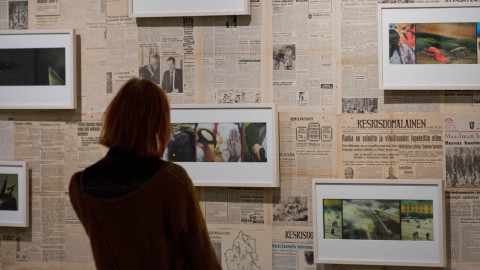Kapa On Secluded Paths
October 19 – January 20, 2019
Holvi
This retrospective exhibition presents the work of one of the most important New Photography pioneers in Finland. The photographer and photography artist, Martti Kapanen (b. 1949) originally from Suolahti, grew up in Imatra. He graduated from the department of photography at the Lahti Institute of Art and Design in 1975, and moved to Helsinki to work as a freelance photographer for women’s magazines. In 1978 he returned to Central Finland to take up the position as the Alvar Aalto Museum’s esteemed architectural photographer until 1990. Although work at the museum was challenging and interesting, it did not fulfill Kapanen’s artistic creative needs. He therefore began to create photographic art on the side and adopted the artist name Kapa. He began to question the heavily documentarian tradition of photography and emphasized the subjective possibilities of the art of photography.
In the beginning of the 1980s, Kapa was one of the founding photography artists of the Jyväskylä based Fotogenesis group that organized exhibitions and published a magazine. The Fotogenesis group won the Finnish State Award in 1984. Martti Kapanen/Kapa strongly influenced the institutional development and value of photography: At the beginning of the 80s, the Alvar Aalto Museum organized their first photography exhibition and photographic art was acquired into the City’s art collection, in 1986 the photography gallery Fotokram was founded, and 1989 brought the Centre for Creative Photography and the first international photography triennial LUMO.
Kapa has never been interested in staying within one theme, style or technique, but rather creates through inspiration. Kapa describes his working process as: I am not a researcher. I am a photographer and my photographs, as the product of my environment, are more like visual thoughts. I don’t have an agenda driving me forward. I am a drifter, the kind criticized as immature in youth, but in an elder might be viewed as a new kind of scavenger.
Right from the beginning, Kapa produced work in series of images. A solo show might solely contain the images of one series and that would also give the exhibition its name. This was the case with Finds in Time (1986–1990), which represented a breakthrough in the artist’s career. Kapa broke the absolutes of time and place in photography and took the protagonist of his series from the past into the present and future by setting up scenes and manipulating negatives. In 1987 the series was published in a book called Finds in Time.
In his work, Kapa often deals with the past, with traces left by people in the landscape and in memories of the past. His series have strongly criticized the radical changes in themes such as National Landscape (After Ski, 1995–1996) and the city image (Corneville Collection, 2003). Human history has also been strongly present in Kapa’s production. In his series Would you believe me if I told you they were heroes (1991–1994) Kapa made collages from old photographs found at the fleemarket and thereby added fictive biographies which he coaxed out of the people in the photos.
Later on, he found his father’s old photo albums and calendars along with his father’s written diary. In addition he found a stack of letters written between his mother and father during the war. This material gave way to the series I always understood it (2005), which tried to give content to his father’s silence, letting him speak about difficult things through images.
Kapa’s photographs are down to earth, soft, with the almost nostalgic colouring of old photographs. For a long time he only produced images in black and white, which he might later colour with oil pastels or watercolours. Strong, glowing colours radiated unexpectedly from his work after travelling to artist residencies in England (Sunderland Colours, 2001) and Benin (African Impact, Villa Karo,2003). From then on, he discontinued his work in the traditional darkroom and completely switched to digital era photography. His first project photographed with a cellphone Journey Home was completed in 2013. In the course of his career, Kapa has experimented with several traditional photography techniques, including Polaroids.

